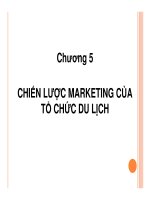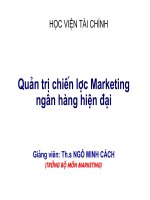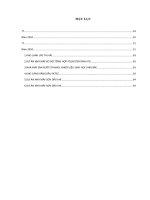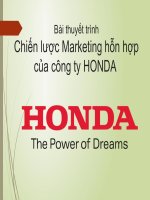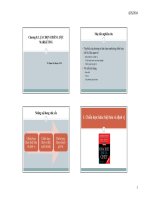slide CHIẾN LƯỢC MARKETING: THE MARKETING PROGRAM
Bạn đang xem bản rút gọn của tài liệu. Xem và tải ngay bản đầy đủ của tài liệu tại đây (2.21 MB, 44 trang )
TRƯỜNG ĐẠI HỌC VĂN LANG
KHOA THƯƠNG MẠI
CHAPTER 6: THE MARKETING PROGRAM
ThS. Nguyễn Quốc Vương
CHAPTER
6
The
Marketing
Program
© 2014 Cengage Learning. All Rights Reserved. May not be scanned, copied or duplicated, or posted to a publicly accessible website, in whole or in part.
The Marketing Program
Marketing Program
The strategic combination of the four marketing mix
elements
The product receives the most attention because
it is most responsible for fulfilling the customers’ needs
and wants.
Involves creating an offering that is an array of
physical (tangible), service (intangible), and
symbolic (perceptual) attributes designed to satisfy
customers’ needs and wants
Due to commoditization, the core product
typically becomes incapable of differentiating
the offering.
Most organizations work to enhance the service
and symbolic elements of their offerings to stand
Product Strategy
Defines
what the organization does and why it
exists
A
product offering’s real value comes from its
ability to deliver benefits that enhance a
customer’s situation or solve a customer’s
problems.
Products
fall into two general categories
Consumer products – for personal use and enjoyment
Business products – for resale, use in making other
products, or use in a firm’s operations
3
© 2014 Cengage Learning. All Rights Reserved. May not be scanned, copied or duplicated, or posted to a publicly accessible website, in whole or in part.
Types of Consumer
Products
(Exhibit 6.1)
Convenience
Products
Shopping
Products
Specialty
Products
Unsought
Products
4
© 2014 Cengage Learning. All Rights Reserved. May not be scanned, copied or duplicated, or posted to a publicly accessible website, in whole or in part.
The Product Portfolio
Product
Product
Line
A group of closely related product items
Mix or Portfolio
The total group of products offered by
the firm
Strategic
Decisions
Variety – number of product lines offered
Assortment – depth of each product line
5
© 2014 Cengage Learning. All Rights Reserved. May not be scanned, copied or duplicated, or posted to a publicly accessible website, in whole or in part.
P&G’s Portfolio of Household Care
Products (Exhibit 6.2)
6
© 2014 Cengage Learning. All Rights Reserved. May not be scanned, copied or duplicated, or posted to a publicly accessible website, in whole or in part.
Potential Benefits of Offering a
Large Product Portfolio
Economies
Package
of Scale
Uniformity
Standardization
Sales
and Distribution
Efficiency
Equivalent
Quality Beliefs
7
© 2014 Cengage Learning. All Rights Reserved. May not be scanned, copied or duplicated, or posted to a publicly accessible website, in whole or in part.
•
•
Consider the number of product choices
available in the Vietnam consumer market.
In virtually every product category,
consumers have many options to fulfill their
needs.
Are all of these options really necessary?
Is having this many choices a good thing
for consumers? Why or why not?
Is it a good thing for marketers and
retailers that have to support and carry all
of these product choices? Why or why
not?
8
© 2014 Cengage Learning. All
All Rights Reserved. May
May not
notbe
be scanned,
scanned,copied
copied or
or duplicated,
duplicated, or
or posted
posted to
to aa publicly
publicly accessible
accessible website,
website, in
in whole
whole or
or in
in part.
part.
The Challenges of Service
Products
Balancing
Time
supply (capacity) with demand
and place dependency of demand
Difficulty
of evaluating service quality prior
to purchase
Inconsistency
of service quality
9
© 2014 Cengage Learning. All Rights Reserved. May not be scanned, copied or duplicated, or posted to a publicly accessible website, in whole or in part.
Unique Characteristics of
Services
(Exhibit 6.3)
Intangibility
Simultaneous
Production and Consumption
Perishability
Heterogeneity
Client-Based
Relationships
10
© 2014 Cengage Learning. All Rights Reserved. May not be scanned, copied or duplicated, or posted to a publicly accessible website, in whole or in part.
Developing New Products
A
vital part of a firm’s effort to sustain growth
and profits
Depends
on the firm’s ability to create a
differential
advantage for the new product
Customer
perception of newness is critical
11
© 2014 Cengage Learning. All Rights Reserved. May not be scanned, copied or duplicated, or posted to a publicly accessible website, in whole or in part.
Strategic Options for Newness of
a
Product
New-to-the-World
Products
(Discontinuous Innovations)
New
Product Lines
Product
Line Extensions
Improvements
or Revisions of Existing
Products
Repositioning
Cost
Reductions
12
© 2014 Cengage Learning. All Rights Reserved. May not be scanned, copied or duplicated, or posted to a publicly accessible website, in whole or in part.
New Product Development Process
Idea
Generation
Screening
and
Evaluation
Development
Test
Marketing
Commercialization
13
© 2014 Cengage Learning. All Rights Reserved. May not be scanned, copied or duplicated, or posted to a publicly accessible website, in whole or in part.
Pricing Strategy
Is
a key factor in producing revenue for the firm
Is
the easiest of all marketing variables to
change
Is
an important consideration in
competitive intelligence
Is
considered to be the only real means of
differentiation in highly commoditized
markets
14
© 2014 Cengage Learning. All Rights Reserved. May not be scanned, copied or duplicated, or posted to a publicly accessible website, in whole or in part.
Key Issues in Pricing
Strategy
The
Firm’s Cost Structure
Perceived
Value
The
Price/Revenue
Relationship
Pricing
Price
Objectives
Elasticity
15
© 2014 Cengage Learning. All Rights Reserved. May not be scanned, copied or duplicated, or posted to a publicly accessible website, in whole or in part.
The Firm’s Cost
Structure
Breakeven
in Units
Total Fixed Costs Unit
Price - Unit Variable Costs
Selling
Price
Average Unit
Cost
1 - Markup Percent (decimal)
16
© 2014 Cengage Learning. All Rights Reserved. May not be scanned, copied or duplicated, or posted to a publicly accessible website, in whole or in part.
Perceived Value
Value
is a customer’s subjective evaluation of
benefits relative to costs to determine the worth of
a firm’s product offering relative to other product
offerings.
Benefits – everything the customer obtains from the
offering
Costs – everything the customer must give up
Value
is intricately tied to every element in
the marketing program.
17
© 2014 Cengage Learning. All Rights Reserved. May not be scanned, copied or duplicated, or posted to a publicly accessible website, in whole or in part.
The Price/Revenue Relationship
Myth
#1 – When business is good, a price cut
will capture greater market share.
Myth
#2 – When business is bad, a price cut
will stimulate sales.
Price
cutting is generally not in the best
interests of
the firm unless sales volume will increase.
A
better strategy is to build value into the
product offering at the same (or even a higher)
price.
© 2014 Cengage Learning. All Rights Reserved. May not be scanned, copied or duplicated, or posted to a publicly accessible website, in whole or in part.
18
Price Elasticity
Refers
to customers’ sensitivity to changes in price
The
relative impact on the demand for a
product, given specific increases or decreases
in the price charged for that product
Perhaps
the most important overall consideration
in setting effective prices.
20
© 2014 Cengage Learning. All Rights Reserved. May not be scanned, copied or duplicated, or posted to a publicly accessible website, in whole or in part.
